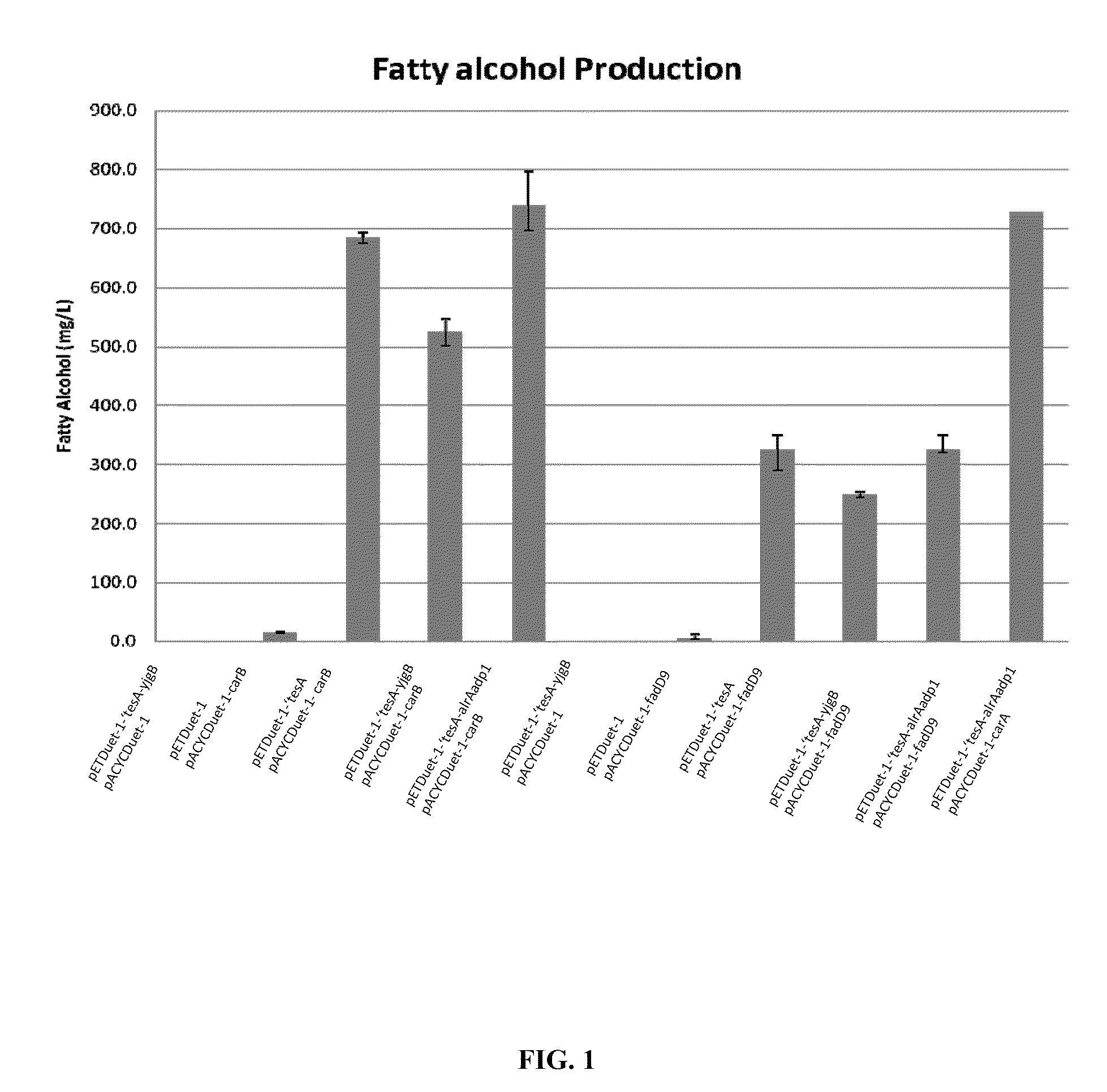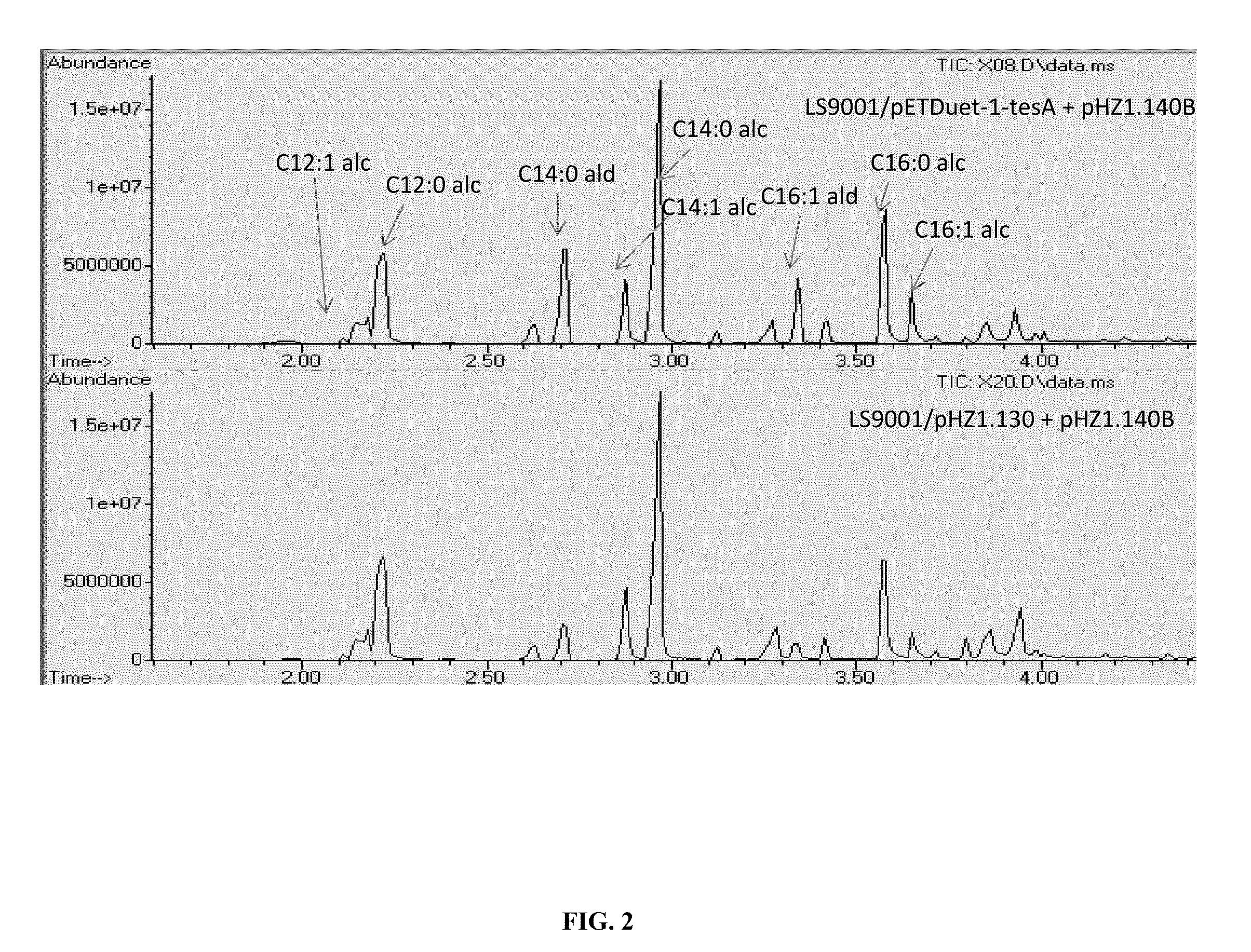Methods and compositions for producing fatty alcohols
a technology of fatty alcohol and composition, applied in the direction of cell culture active agents, chemical/physical processes, enzymemology, etc., can solve the problems of high cost of petroleum products development, high cost, financial and environmental impact,
- Summary
- Abstract
- Description
- Claims
- Application Information
AI Technical Summary
Benefits of technology
Problems solved by technology
Method used
Image
Examples
example 1
Identification of Carboxylic Acid Reductase (CAR) Homologs
[0372]The carboxylic acid reductase (CAR) from Nocardia sp. strain NRRL 5646 can reduce carboxylic acids (e.g., fatty acids) into their corresponding aldehydes without utilizing separate activating enzymes, such as acyl-CoA synthases (Li et al., J. Bacteriol. 179:3482-3487, 1997; He et al., Appl. Environ. Microbiol. 70:1874-1881, 2004)).
[0373]A BLAST search using the NRRL 5646 CAR amino acid sequence (Genpept accession AAR91681) (SEQ ID NO:16) as the query sequence identified approximately 20 homologous sequences. Three homologs, listed in Table 7, were evaluated for their ability to convert fatty acids into fatty aldehydes in vivo when expressed in E. coli.
[0374]At the nucleotide sequence level, carA (SEQ ID NO:19), carB (SEQ ID NO:21), and fadD9 (SEQ ID NO:17) demonstrated 62.6%, 49.4%, and 60.5% homology, respectively, to the car gene (AY495697) of Nocardia sp. NRRL 5646 (SEQ ID NO:15). At the amino acid level, CARA (SEQ ...
example 2
Identification of Alcohol Dehydrogenase Genes
[0375]E. coli contains at least one enzyme that catalyzes the reversible oxidoreduction of fatty aldehydes and fatty alcohols (i.e. fatty aldehyde reductase / alcohol dehydrogenase). Reverse engineering was used to identify such fatty aldehyde reducatases / fatty alcohol dehydrogenses in E. coli MG1655 cells expressing the acyl-ACP reductase YP—400611 from Synechococcus elongatus (Synpcc7942 1594) (SEQ ID NO:196). Four 3 ml, LB cultures were grown overnight at 37° C., and 55 mL of stationary phase cultures were used to inoculate four independent 5.5 mL of LB. Those 5.5 mL cultures were then grown to an OD600 of 0.8-1.0 and were then used to inoculate a corresponding number of 2 L baffled shakeflasks, each with 500 mL Hu-9 minimal media. 20 hrs after induction the cells were pelleted at 4,000×g for 20 min. The cell pellet was resuspended in 30 mL of 100 mM phosphate buffer at pH 7.2 with 1× Bacterial Protease Arrest (G Biosc...
example 3
Expression of CAR Homologs and Alcohol Dehydrogenase in E. coli
A. CAR Plasmid Construction
[0387]Three E. coli expression plasmids were constructed to express the genes encoding the CAR homologs listed in Table 7. First, fadD9 was amplified from genomic DNA of Mycobacterium tuberculosis H37Rv (obtained from The University of British Columbia, and Vancouver, BC Canada) using the primers fadD9F and FadDR (see Table 9). The PCR product was first cloned into PCR-blunt (Invitrogen) and then released as an NdeI-AvrII fragment. The NdeI-AvrII fragment was then cloned between the NdeI and AvrII sites of pACYCDuet-1 (Novogen) to generate pACYCDuet-1-fadD9.
[0388]The carA gene was amplified from the genomic DNA of Mycobacterium smegmatis MC2 155 (obtained from the ATCC (ATCC 23037D-5)) using primers CARMCaF and CARMCaR (see Table 9). The carB gene was amplified from the genomic DNA of Mycobacterium smegmatis MC2 155 (obtained from the ATCC (ATCC 23037D-5)) using primers CARMCbF and CARMCbR (se...
PUM
 Login to View More
Login to View More Abstract
Description
Claims
Application Information
 Login to View More
Login to View More - R&D
- Intellectual Property
- Life Sciences
- Materials
- Tech Scout
- Unparalleled Data Quality
- Higher Quality Content
- 60% Fewer Hallucinations
Browse by: Latest US Patents, China's latest patents, Technical Efficacy Thesaurus, Application Domain, Technology Topic, Popular Technical Reports.
© 2025 PatSnap. All rights reserved.Legal|Privacy policy|Modern Slavery Act Transparency Statement|Sitemap|About US| Contact US: help@patsnap.com



